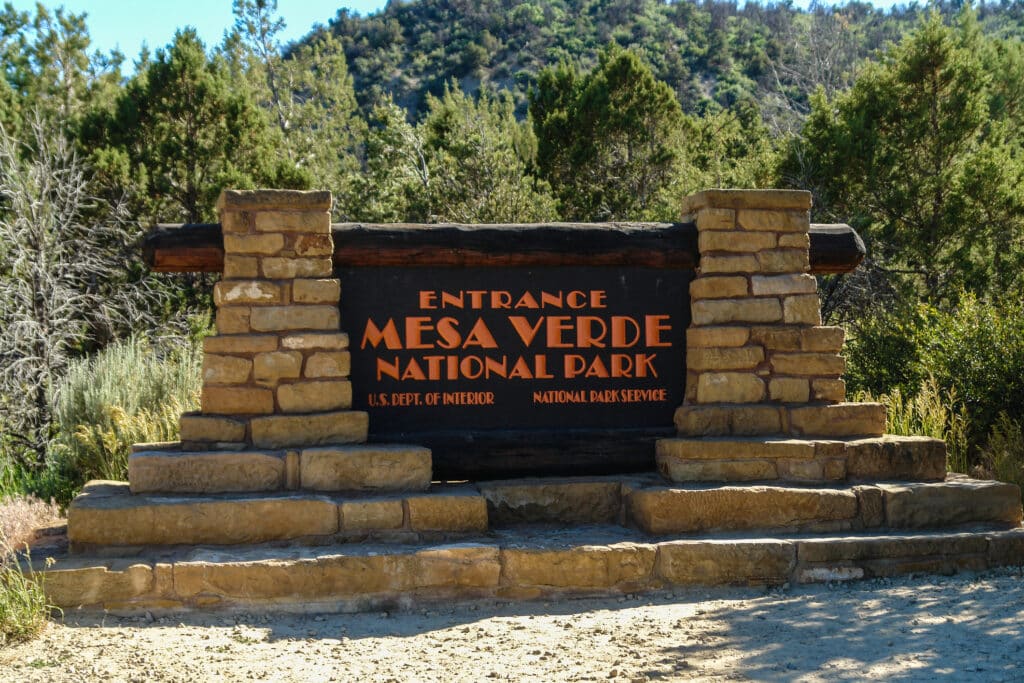
Mesa Verde National Park currently requires an entrance fee (no advance reservations needed). In peak season (May 1 – Oct 22), a 7-day pass costs $30 per vehicle (private car, covering all passengers) or $25 per motorcycle. Individuals entering on foot or bicycle pay $15 per person (children 15 and under are free).
In the off-season (Oct 23 – Apr 30), rates drop to $20 per vehicle and $15 per motorcycle, while the per-person fee remains $15. An annual Mesa Verde park pass is available for $55, and of course America the Beautiful interagency passes are accepted.
Note: The park’s entrance stations do not accept cash, so have a credit or debit card ready.
The park is open year-round, 24 hours a day, though visitor facilities and cliff dwelling tour operations have seasonal hours. During summer months, most ancient site areas, trailheads and picnic spots open around 8:00 AM and close by sunset. The main entrance gate is staffed extended hours in peak season (often from about 7:00 AM until 10:00 or 11:00 PM), with shorter operating hours (e.g. 8:00 AM – 4:00 PM) during winter. Some parts of the park are seasonal – for example, the Wetherill Mesa section (home to sites like Long House) is open only in summer (generally late May through late September, with last daily entry in early afternoon). We visited on 18 July 2025, and all figures were valid then.
Detailed Park Overview
Mesa Verde is not your typical national park – it stands out as a profound blend of cultural history and natural beauty. Established in 1906 by President Theodore Roosevelt, it was the first national park created explicitly to preserve archaeological treasures (“to preserve the works of man”). This high plateau in southwestern Colorado protects the elaborate cliff dwellings and mesa-top villages of the Ancestral Pueblo people who lived here from around 550 AD to 1300 AD.
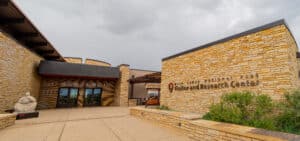
Exterior view of the Mesa Verde National Park visitor center
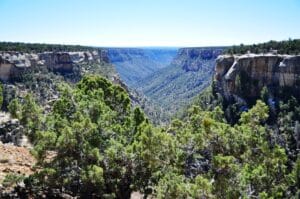
Mesa Verde National Park, Colorado
What makes Mesa Verde so special among America’s parks? Simply put, it’s like time-traveling into an ancient civilization’s home. The park contains over 5,000 archaeological sites, including approximately 600 cliff dwellings tucked beneath sandstone alcoves – the largest concentration of such sites in the United States. Its global importance has been recognized by UNESCO, which designated Mesa Verde a World Heritage Site in 1978. (It was also once rated the “#1 Historic Monument in the World” by Condé Nast Traveler magazine and counted among National Geographic’s “50 Places of a Lifetime.”) Visitors here can marvel at superbly preserved structures like Cliff Palace, a multi-story complex of 150 rooms and 23 kivas (ceremonial circular chambers) built into a gigantic rock alcove – it’s the park’s most famous site and an icon of southwestern archaeology. It’s no surprise its a place of worldwide renown and scholarly study. But Mesa Verde isn’t just about viewing static ruins behind ropes – it’s a living museum of the past that we got to explore in person, climbing ladders and peering into stone dwellings where people raised families over seven centuries ago.
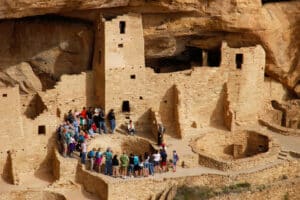
Cliff Palace, Mesa Verde National Park, Colorado, USA
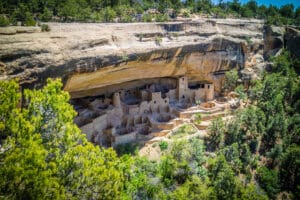
The Cliff Palace in Mesa Verde National Park, Colorado.
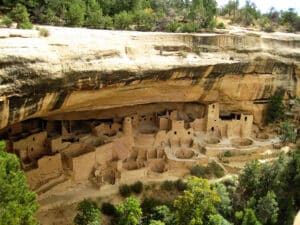
Cliff Palace in Mesa Verde National Park (Colorado, USA).
Beyond the archaeology, the natural setting of Mesa Verde is impressive in its own right. The name means “green table” in Spanish, alluding to the park’s broad, flat-topped mesas covered in pinyon-juniper woodlands. These mesas rise sharply above the surrounding high desert plains; elevations in the park range from around 6,000 feet to 8,572 feet at Park Point. From those heights you can see a patchwork of deep sandstone canyons, rugged buttes and distant mountain ranges on the horizon. The climate is semi-arid, with hot summers (mid-day sun can get kinda intense) and cold snowy winters.
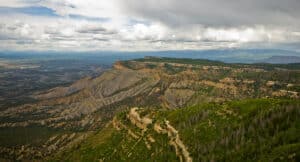
The view from Lookout Point at Mesa Verde National Park.
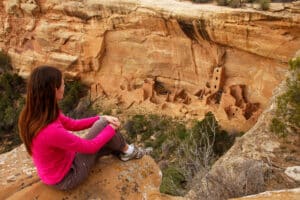
In the warmer months, wildflowers dot the hillsides and afternoon thunderstorms occasionally roll in, bringing dramatic skies and much-needed rain. Mesa Verde’s flora includes hardy species like Utah juniper, pinyon pine, sagebrush and rabbitbrush, as well as colorful wildflowers in season (we spotted vibrant Indian paintbrush along one trail).
The fauna and critters of the area are adapted to this landscape too. Mule deers, coyotes, and wild turkeys are commonly seen, and black bears, mountain lions, bobcats and foxes also roam more discreetly in the canyons. Smaller animals like cottontail rabbits, lizards and chipmunks frequently scurry about the sage and underbrush. We learned that some species here are protected – for instance, the Mexican spotted owl (a threatened species) finds refuge in the cliff alcoves and old-growth forests of the park. Park management takes conservation seriously, balancing visitor access with preserving both the cultural sites and the ecosystem. You’ll notice signs reminding to stay on trails to protect fragile vegetation and unstable archaeological areas.
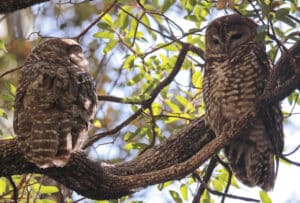
Pair of Mexican Spotted Owls in Their Roost
Wildfire is another big concern: in the early 2000s, several large wildfires swept through Mesa Verde, burning nearly half of the park’s forested lands. In their aftermath, the park began implementing proactive fire management policies – controlled burns, vegetation thinning around key sites, and careful monitoring – to reduce the risk of catastrophic fires and to protect both the ancient dwellings and new growth forests. Driving through, we saw hillsides of young aspens and oak brush coming back where older pines once stood, a testament to the landscape’s resilience. The sight of charred tree trunks alongside new green growth really underscores how natural forces and human history intersect at Mesa Verde.
For visitors, Mesa Verde offers a rich, immersive experience into the past. How much time do you need here? We’ve found that one full day can be sufficient to see the major highlights, but two days allows a more relaxed pace especially if you want to hike some trails. On average, many travelers spend around 7-8 hours in the park, which is enough for a couple of cliff dwelling tours and a driving loop with viewpoint stops. Our advice: start your visit early in the morning to maximize daylight and beat the crowds. The park’s main highlights are along two mesa-top roads: Chapin Mesa (open year-round) and Wetherill Mesa (summer-only). A popular first stop is the Mesa Verde Visitor and Research Center near the entrance, where museum exhibits and a helpful orientation film provide background on the Ancestral Puebloan culture. From there, a 45-minute scenic drive up steep switchbacks takes you onto Chapin Mesa, where most famous sites are located.
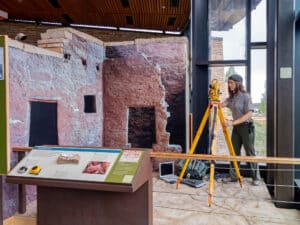
Mesa Verde National Park visitor center
The Mesa Top Loop Drive on Chapin Mesa is a 6-mile paved loop dotted with short interpretive trails and overlooks. We drove this loop and stopped at viewpoints overlooking cliff dwellings like Spruce Tree House and Square Tower House (both visible from across the canyon). These pullouts are great for getting context and photos without much walking. The loop also passes surface ruins on the mesa top – remnants of pit houses and masonry villages built before the Pueblo people moved into the cliffs. It was amazing to imagine families living on those same mesas over a thousand years ago, farming the land and eventually constructing the elaborate communities in the cliffs below. Several short hiking trails branch off in this area too. One of the most popular is the Petroglyph Point Trail, a 2.4-mile (3.9 km) loop starting near the Chapin Mesa Archaeological Museum; it leads to a panel of ancestral rock carvings. We’ll share more about that hike in a bit.
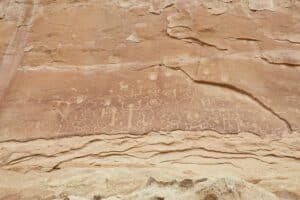
The Petroglyph Trail of Mesa Verde National Park, Colorado.
Another easy walk led us to Spruce Tree House Overlook, since Spruce Tree House dwelling itself is currently closed to public entry for preservation work – but from a designated viewpoint we could still appreciate its clustered rooms under a huge arching cliff. If you’re up for a bigger hike, Prater Ridge Trail and Knife Edge Trail near the Morefield Campground offer quiet pathways through spruce-fir forest and high overlooks of Montezuma Valley (these are moderate, longer trails with fewer people).
Keep in mind that guided tours are the only way to enter most cliff dwellings like Cliff Palace, Balcony House and Long House. Tickets for these ranger-led tours can be reserved online in advance or sometimes obtained same-day at the visitor center if any remain. We recommend snagging an early morning tour slot – the temperatures are cooler and the groups tend to be smaller first thing in the morning, making for a more intimate experience. (Not a fan of crowds? Going on the first tour of the day at Cliff Palace, around 9:00 AM, we found only a handful of other visitors with us, which was perfect.) By contrast, midday tours often sell out and you might feel a bit rushed with larger groups. In any case, a guided tour is absolutely worth it to fully appreciate the ingenuity of the people who built these dwellings and to get inside these ancient rooms safely.
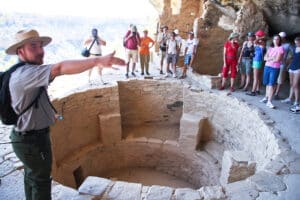
A Park Ranger lectures visitors to Cliff Palace, Mesa Verde National Park
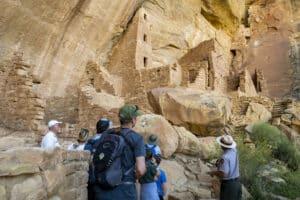
Mesa Verde National Park – Square Tower House Tour, Mesa Verde National Park.
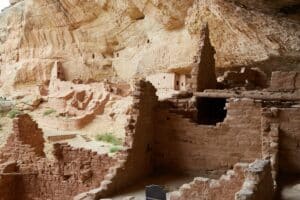
Mesa Verde National Park – Guided Tours
The rangers share fascinating tidbits – from explaining how the Puebloans collected water from seep springs in the cave alcoves, to pointing out soot on the ceiling from centuries-old hearth fires. It’s a humbling experience to stand where others lived so long ago. Overall, Mesa Verde combines national park scenery with an archaeological adventure.
We came away with a deeper understanding of Ancestral Pueblo life and a real admiration for the park’s preservation efforts. There’s truly no other place where you can hike through fragrant juniper forests in the morning, climb down a ladder into a 13th-century cliff house by midday, and then watch a golden sunset from a high mesa point in the evening. We’re happy to recommend this park to anyone interested in history, archaeology or just a unique outdoor experience – it’s a must-see that left a strong impression on us.
Surrounding Areas: Best Trails & Dining
Ever wanted to step inside an ancient cliff dwelling? At Mesa Verde, you actually can – and we did. During our stay, we explored a variety of sights both inside the park and around its edges. Below we list some of the highlights and nearby favorites we experienced (all descriptions in past tense, as we’re sharing our personal visit):
-
Cliff Palace Tour: We joined a ranger-guided tour of Cliff Palace, the park’s largest cliff dwelling. Starting early in the morning, we descended a stone stairway and climbed a few sturdy ladders down into the dwelling. Up close, Cliff Palace was even more impressive – a maze of sandstone rooms and round kivas sheltered by a huge curved alcove overhead. We were able to walk within the plaza area, gazing up at the original plastered walls and through windows of structures built circa 1200 CE. It felt almost surreal to stand inside this 800-year-old “palace.” The ranger explained how families lived in these small rooms and likely used the open courtyards for daily activities. We listened to tales of how it was rediscovered in 1888 and studied some faint handprint pictographs on the walls that the ancestral inhabitants left behind. Standing there, with swallows darting in and out of the alcove, was humbling – as if we were guests in someone’s ancient home. It’s an experience we’ll never forget and strongly advise doing when at Mesa Verde. (Tip: We recommend booking the first tour of the day here; our 9 AM tour had fewer people and the soft morning light in the alcove was magical.)
-
Park Point Overlook: In the late afternoon, we drove up to Park Point, the highest spot in Mesa Verde (elevation 8,572 ft). A short paved path led to a historic fire lookout tower on the peak. From this vantage point, we had a 360-degree panoramic view that truly took our breath away. Looking north, we could see the distant San Juan Mountains with still a few streaks of snow on the tallest peaks. To the south and west sprawled the red-rock canyons of the Four Corners region, fading into the horizon. We could even spot Shiprock (a famous solitary mountain in New Mexico) way off in the distance. A handy orientation sign helped us identify the visible landmarks and the four states meeting in the distance. The air up there was cool and breezy, a nice break from the heat below. We sat at a picnic table near the lookout, snacking and just soaking in the view for a while. It was a peaceful capstone to a day of exploration, watching the shadows grow long across the “green table” of Mesa Verde.
-
Petroglyph Point Trail: We hiked the Petroglyph Point Trail, a 2.4-mile loop that starts behind the Chapin Mesa Museum. This trail gave us a fun bit of adventure. It wound along the side of a canyon through pinyon pine and juniper trees, with some narrow passages where we scrambled between sandstone boulders. The path was rocky and kinda steep in a few short sections – nothing too difficult, but we did have to watch our footing carefully. Midway through the hike, we reached the highlight: a large panel of ancestral petroglyphs etched into a cliff face. We almost missed it at first, then suddenly the petroglyphs appeared right in front of us – dozens of symbols and figures carved by the Pueblo people centuries ago. We paused here for a while, deciphering the human-like figures and zig-zag patterns in the rock (a nearby sign gave insight into their possible meanings, like symbols for journeys or clan signs). It’s amazing to think these carvings have survived in the open for so long. After the petroglyph panel, the trail climbed up some stone steps to the mesa top, rewarding us with an overlook of Spruce Canyon. The last stretch back to the museum was mostly flat and easy. Overall, this loop took us about 2 hours at a leisurely pace. We’d suggest wearing good shoes and carrying water – and don’t forget to turn around occasionally for great views of Spruce and Navajo Canyons behind you on the way up.
-
Morefield Campground: We spent one night camping at Morefield Campground, the park’s developed campground located just 4 miles inside the entrance. Tucked in a broad canyon, Morefield has over 250 campsites but it was only sparsely occupied during our stay (weekday in June). We set up our tent beneath juniper and gamble oak trees, with mule deer grazing quietly in the distance during dusk. The campground had terrific amenities: clean restrooms with hot showers, a coin laundry, and even a small camp store and cafe (the Knife Edge Café at the campground served us a hearty pancake breakfast the next morning!). After dinner, we took a short walk on the Knife Edge Trail, a gentle path starting near the campground that led us out to a viewpoint of Montezuma Valley. As night fell, the sky at Morefield was phenomenal. At this high elevation and distance from city lights, we saw countless stars and even the hazy band of the Milky Way arching overhead. It was the perfect place for stargazing – we simply lay back at our site and looked up in awe. The quiet of the campground at night, with only the sound of a faint breeze in the pines, made it a very restful night. If you enjoy camping, we certainly recommend spending a night here to experience Mesa Verde after dark.
-
Metate Room Restaurant: One evening we treated ourselves to dinner at the Metate Room, the park’s fine-dining restaurant located in Far View Lodge. After a week of camp meals, this felt quite luxurious! The restaurant’s atmosphere was casual but elegant, with panoramic windows looking out over the surrounding mesas (we timed our reservation to catch the sunset). The menu features contemporary Southwestern cuisine using local ingredients. We started with the Navajo taco appetizers – fry bread topped with bison chili, beans and cheese – which were delicious. For our main courses, we tried the grilled trout (caught from nearby waters) and a tender elk medallion dish, both served with seasonal vegetables. Each dish was thoughtfully prepared and beautifully presented; it’s not often you get gourmet options in a national park. As the sun went down, the walls of the dining room glowed warm and orange, and we could see lights twinkling in the towns far below the mesa. We finished with a dessert of prickly pear cheesecake, enjoying every bite. The Metate Room was a splurge for us budget-wise, but absolutely worth it – a memorable dining experience right inside the park. (Travel tip: The Metate Room is only open roughly mid-April through mid-October when the lodge is operating, so plan accordingly if visiting in winter.)
-
Local Flavors in Mancos: Just outside the park boundary, the closest town is Mancos, Colorado (about a 10-minute drive from the entrance). One afternoon, after wrapping up our Mesa Verde explorations, we headed into Mancos to check out its local food scene. We stopped at the historic Columbine Bar & Grill on Grand Avenue – a no-frills tavern established in 1910, popular with both locals and visitors. The Columbine is known for its burgers, so of course we had to try the signature “Mesa Verde Burger.” This juicy burger came topped with roasted green chiles, crispy bacon, and pepper jack cheese, giving it a wonderful spicy kick and regional Southwestern flavor. It was served up with a side of hand-cut fries and a big dill pickle. After days of camp cooking, biting into that flavorful burger was pure joy! We washed it down with pints of cold beer from the nearby Mancos Brewing Company. The bar had a relaxed small-town vibe – friendly folks, cowboy hats at the counter, and old black-and-white photos of Mancos on the walls. Chatting with the bartender, we learned that green chile on burgers is a Colorado/New Mexico specialty (one we’ll gladly remember). If you’re craving a hearty meal or just a cold drink after hiking in the park, we can vouch that the Columbine in Mancos is a great choice.
-
Art & Coffee in Town: Before leaving Mancos, we also took a little time to explore the town’s quaint Main Street, which has a budding arts scene. We browsed the Artisans of Mancos gallery, a cooperative shop where local artists display pottery, jewelry, textiles, and paintings. It was fascinating to see modern creative work after being immersed in ancient art at Mesa Verde – a sort of connecting of past and present craftsmanship. The gallery owner greeted us warmly and gave insight into some of the pieces (we ended up buying a small handmade ceramic bowl as a souvenir). Afterwards, we popped into a cozy café just down the street for an afternoon pick-me-up. The café (a locally-owned spot with a chalkboard menu) served excellent drip coffee and homemade pie. Sipping our coffees and enjoying a slice of warm apple pie, we reflected on our Mesa Verde adventures. The comfortable small-town atmosphere in Mancos was a pleasant complement to the wildness and history we’d experienced up on the mesa. It made us appreciate the trip even more – not only did we get to see incredible ancient ruins in the national park, but we also connected with the local culture and community that surrounds Mesa Verde today.
Our journey through Mesa Verde National Park was enriching and eye-opening. From clambering through cliff dwellings to gazing over vast mesa panoramas, every part of the visit offered something unique. We left Mesa Verde with a newfound respect for the ancestral Pueblo people who thrived in this challenging landscape, and for the rangers and researchers working to protect their legacy. This special place truly is where nature and history meet, and experiencing it firsthand was well worth it. We’re already looking forward to a future trip – there are still backcountry hikes we haven’t done and lesser-known ruins to see. Until next time, Mesa Verde!
Sorry, there were no items that matched your criteria.

